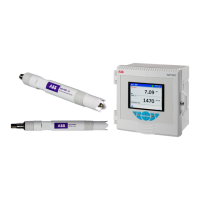AWT420 | UNIVERSAL 4-WIRE, DUAL-INPUT TRANSMITTER | OI/AWT420-EN REV. B
103
Monitoring on solid alkaline treated systems
Generally, boiler waters treated with solid alkaline chemicals,
for example, sodium hydroxide, have relatively high
conductivities.
The dual input conductivity analyzer, in conjunction with a
cation resin column, can be used to indicate sample pH. If the
sample also contains salts (e.g. sodium chloride), the after-
cation conductivity reading reflects the acid conductivity
released by the salts, the reading is typically 3 times higher
than normal owing to the acid. Hence, to derive the
cation conductivity increase must be subtracted from the
before-column reading. In addition, a factor must be applied
for the molar conductivity change of the alkaline agent.
The analyzer software applies the following equation:
log(BC –
1
/3AC)
1 +
Where:
-1
per mmol/l
for sodium hydroxide)
The maximum after-cation conductivity value is programmable
-1
dependent on local conditions.
After-cation values above this level generate an AFTER CAT.
HIGH
cm
-1
generate a BEFORE CAT. HIGH error message. The inferred
pH range is 7 to 11 pH, values above 11 pH generate an Infr. pH
invalid error message. Refer to page 83 for a description of
error messages..
The inferred pH feature can be used on solid alkali treated
systems only in the following circumstances:
1 On steam raising plant.
2 For boiler chemical treatment such as sodium hydroxide. In
this instance, A: Temp. Comp. must be set to NaOH and B:
Temp. Comp. must be set to ACID.
3 Where the after-cation conductivity value is less than
-1
.
NOTICE
Inferred pH measurement on AVT systems is inappropriate
to chemical treatments such as sodium phosphate, sodium
hydroxide and morpholine.

